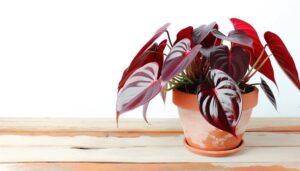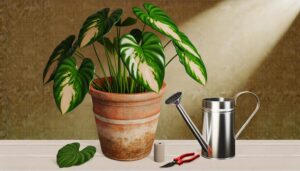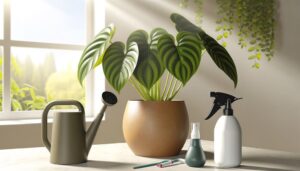Variegated Philodendron Care
Variegated Philodendrons, tropical plants indigenous to the Americas, need bright, indirect light, as direct sunlight might trigger leaf burn. It's vital to maintain the soil moderately moist, preventing water saturation to avoid root rot.
This species flourishes at temperatures ranging from 65-80°F and humidity levels of 40-60%. Planting in well-draining, slightly acidic soil with added organic material ensures their vigorous growth.
Early detection of common diseases like leaf spot and root rot is crucial, with treatments such as copper-based fungicides considered effective. Delving deeper into the topic will provide you with a more thorough grasp of these plants' requirements.
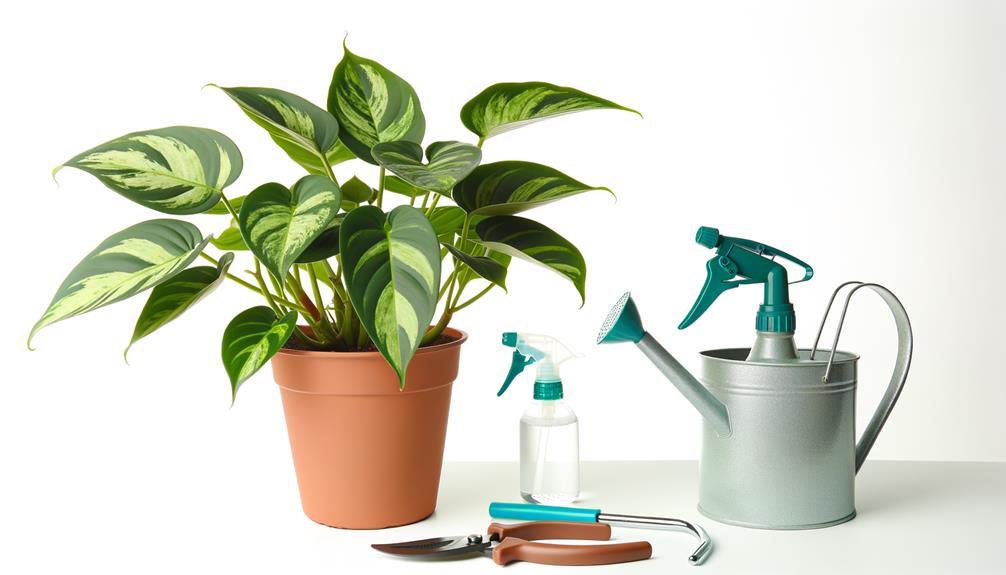
Key Takeaways
- Variegated Philodendron thrives in bright, indirect sunlight and temperatures between 65-80°F.
- Keep the soil moderately moist, but avoid waterlogging to prevent root rot.
- Use well-draining, slightly acidic soil and pots with good drainage for healthy growth.
- Maintain ideal humidity levels between 40-60% and mist regularly in low-humidity conditions.
- Identify and treat plant diseases promptly using appropriate fungicides, insecticidal soaps, or neem oil.
Understanding Variegated Philodendron

While the variegated philodendron is a popular houseplant due to its strikingly diverse leaf coloration, understanding its unique biological characteristics and care requirements is essential for promoting its healthy growth.
This plant belongs to the Araceae family and is native to the tropical regions of the Americas. Its name, 'variegated', refers to the chimeric patterns on its leaves, caused by a lack of chlorophyll in some cells, which results in green and non-green sections.
It thrives in a well-draining, peat-based potting mix, with a pH of 6.0-7.0. The plant requires moderate watering, taking care to avoid waterlogging which can lead to root rot.
Indoor temperatures of 15-30°C are ideal, with humidity levels maintained at 40-60%.
Ideal Lighting Conditions
The variegated philodendron's unique leaf coloration is best showcased under optimal lighting conditions, which involve bright, indirect sunlight, as direct exposure can cause leaf burn and faded variegation. This species thrives in diffused light that mimics the understory of its native tropical rainforest habitat, rather than the harsh, unfiltered sunlight found in more exposed locations.
A north or east-facing window is typically ideal, providing the right spectrum of light without the risk of overheating. If indoor light conditions are insufficient, artificial lighting can be used to supplement natural light. A balanced red and blue spectrum LED grow light can effectively support the plant's photosynthesis process.
Proper lighting is essential in maintaining the plant's vibrant leaf variegation and overall health.
Watering Requirements

After ensuring your variegated philodendron is receiving the right amount of light, it's equally important to understand its watering needs to maintain its overall health and to prevent common plant diseases.
These plants thrive on careful, intentional watering. The soil should be kept moderately moist, but never waterlogged. Over-watering can lead to root rot, a prevalent issue that can negatively impact plant health. Conversely, under-watering can induce stress, causing leaf yellowing and wilting.
Use a moisture meter to accurately gauge the plant's water needs. Water thoroughly until excess drains from the bottom, then allow the top inch of soil to dry out before the next watering. Adapting to the plant's signals and adjusting watering practices accordingly is key to its thriving growth.
Temperature and Humidity Preferences
In the domain of temperature and humidity preferences, variegated philodendrons prefer a tropical climate, which includes warm temperatures ranging between 65 to 80 degrees Fahrenheit and high humidity levels. This plant's adaptability to diverse indoor environments has made it a popular choice among plant enthusiasts and service-oriented individuals who desire to beautify communal spaces.
To provide a clearer picture, here's a table detailing the ideal conditions for this plant:
| Temperature Range (°F) | Optimum Humidity (%) | Remarks |
|---|---|---|
| 65 – 70 | 40 – 60 | Perfect for growth |
| 70 – 75 | 60 – 80 | Promotes lush foliage |
| 75 – 80 | 80 – 100 | Requires regular misting |
| Below 65 or Above 80 | Below 40 or Above 100 | Can cause stress, wilting |
Soil and Potting Guidelines
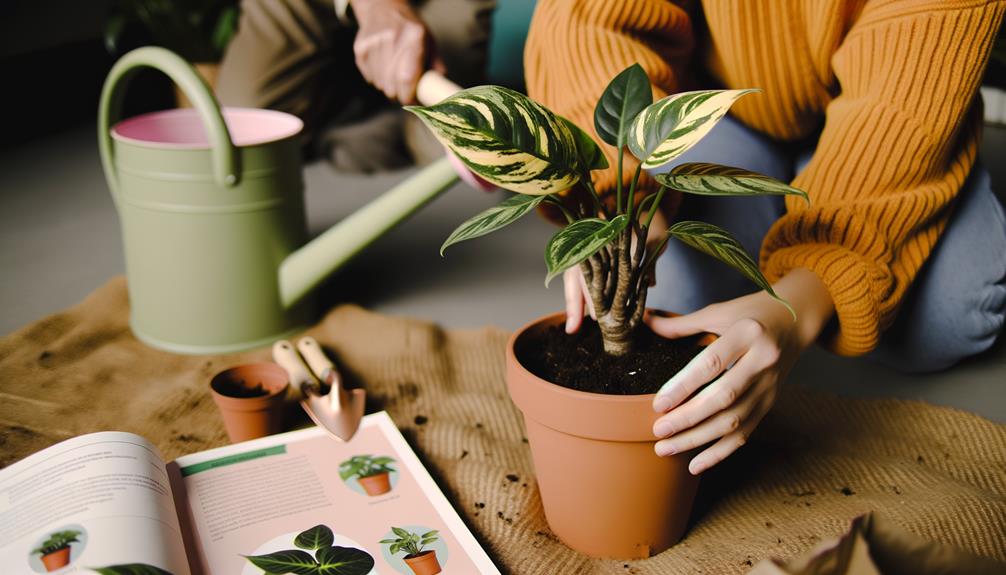
The critical aspects of variegated philodendron care include not only the correct temperature and humidity but also the appropriate soil and potting practices.
The selection of suitable soil and the implementation of best potting techniques greatly influence the plant's health and growth.
This section will detail the process of selecting the right soil, elucidate the most effective potting techniques, and provide helpful tips for repotting the variegated philodendron.
Choosing the Right Soil
Selecting a suitable substrate forms the critical foundation for your variegated Philodendron's health, with a preference for well-draining, rich, and slightly acidic soil. The ideal pH range is between 6.0 and 7.0. This range promotes best nutrient absorption, fostering robust growth and variegation.
Consider incorporating organic matter, like compost or well-rotted manure, into your soil. These amendments improve soil structure, enhancing its ability to retain necessary nutrients while draining excess water. In addition, they introduce beneficial microorganisms that aid in nutrient breakdown and absorption.
Perlite or coarse sand can also be added to improve drainage. Avoid using heavy clay soils as they retain water and can lead to root rot, a common problem in waterlogged conditions.
Ideal Potting Techniques
Proper potting techniques for your variegated Philodendron can greatly influence its overall health and foliage vibrancy. This requires a careful selection of an ideal pot, in addition to the previously discussed soil considerations.
For this, consider factors such as pot size, material, drainage, and compatibility with the plant's growth habit.
- *Pot Size*: Choose a pot that is just slightly larger than the root ball, allowing for adequate growth without overwhelming the plant.
- *Material*: Ceramic or terracotta pots are often essential, as they are porous and allow for good air and water exchange.
- *Drainage*: It is vital for the pot to have excellent drainage to prevent water-logging and root rot.
- *Compatibility*: The pot should accommodate the plant's epiphytic growth habit, allowing it to trail or climb as it would in its natural environment.
Plant Repotting Tips
Understanding the intricacies of repotting variegated Philodendrons can greatly enhance their significance and growth, requiring thoughtful consideration of soil type, pot selection, and the timing of the repotting process.
The soil should be well-draining, rich in organic matter, and have a pH range of 6.0 to 7.0. Peat-based potting mixes are ideal. When selecting a pot, make sure it is large enough to accommodate growth yet not so oversized that it retains excess moisture. Plastic or ceramic pots with drainage holes are recommended.
Repotting should be done during the growing season, ideally in the spring. Carefully remove the plant from its current pot, minimizing root disturbance. Prune any damaged roots, position the plant in the new pot, and gently backfill with soil.
Pruning and Propagation Tips
To guarantee the continued growth and health of your variegated philodendron, it is pivotal to implement strategic pruning and propagation techniques. Effective pruning can stimulate new growth, while propagation allows you to multiply your plant through cuttings.
Here are four key tips to keep in mind:
- Use sharp, sterilized pruning shears to avoid damaging the plant or introducing disease.
- Prune during the growing season, which is typically spring or early summer.
- For propagation, choose healthy, mature leaves. Cut just below a leaf node and place the cutting in water.
- Monitor the cutting, changing the water every few days, until roots emerge.
Identifying and Treating Diseases
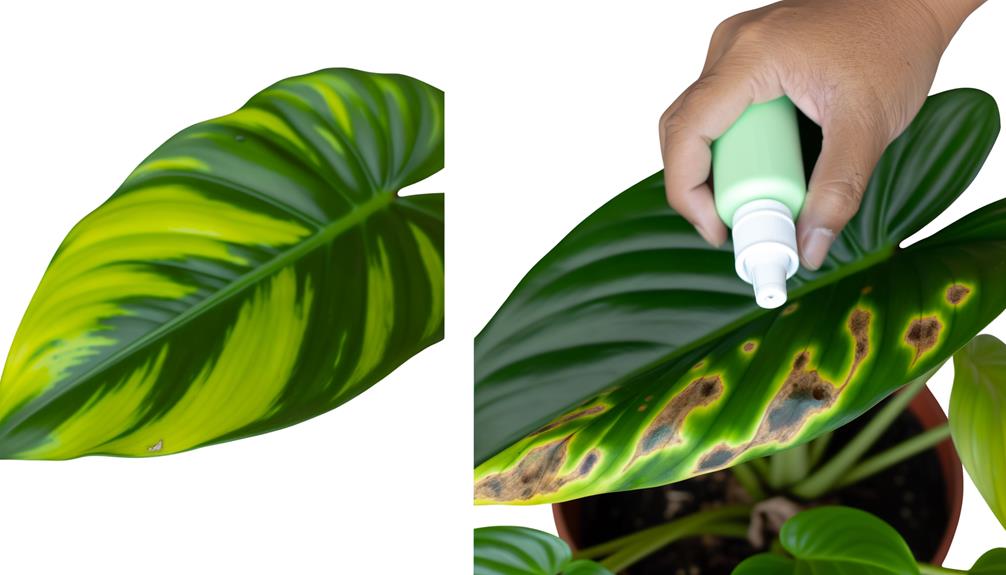
The health and longevity of your Variegated Philodendron greatly relies on your ability to promptly identify and effectively treat common plant diseases. By understanding the symptoms linked with prevalent diseases, intervention can be timely, preventing the potential spread and damage.
Subsequently, we will explore the identification of these diseases, followed by a discussion on the most effective treatment methods to guarantee the sustained vigor of your plant.
Recognizing Common Plant Diseases
In the world of variegated philodendron care, watchfulness in recognizing and treating common plant diseases plays an essential role in maintaining the health and vibrancy of these tropical plants.
- Leaf Spot Disease: Manifests as dark, wet spots with a yellow halo on leaves. It's caused by pathogenic fungi or bacteria.
- Root Rot: Indicated by yellowing leaves and wilting despite adequate watering. Usually due to overwatering or poorly drained soil.
- Viral Diseases: Symptoms include mosaic patterns or ring spots on leaves. Transmitted through insect vectors or infected tools.
- Powdery Mildew: Appears as powdery white spots on leaves and stems. Favored by high humidity and poor air circulation.
These maladies, if not promptly addressed, can seriously compromise the plant's strength. Regular inspection is essential for early detection and intervention.
Effective Treatment Methods
Upon identifying the early signs of disease in your variegated philodendron, swift and effective treatment methods must be implemented to protect the plant's wellbeing and sustain its growth.
One common problem is leaf spot, which can be effectively treated using a copper-based fungicide. Apply it thoroughly over the plant, ensuring to cover both the upper and lower leaf surfaces.
For root rot, remove the affected roots and treat the plant with a fungicide containing mefenoxam.
If your plant is infested with pests like aphids or spider mites, an insecticidal soap or neem oil can be used.
Always remember, prevention is better than cure. Maintain good hygiene, provide adequate light, water, and humidity, and your philodendron will thrive.
Conclusion
To sum up, the cultivation of variegated philodendron requires a keen understanding of its inherent nature. Adherence to ideal lighting conditions, watering schedules, temperature and humidity preferences can guarantee a thriving plant.
A conducive soil environment and appropriate potting play crucial roles. Regular pruning and correct propagation can foster growth.
Regular monitoring can aid in the early detection and treatment of diseases, securing the longevity of this beautiful foliage plant.


